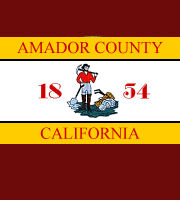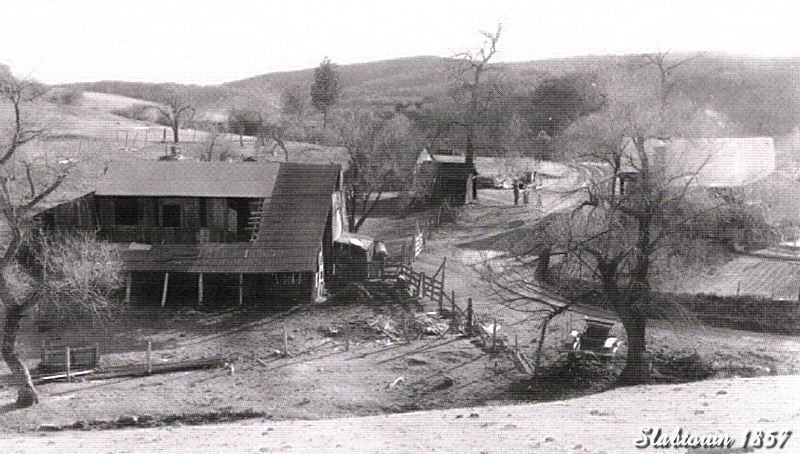





|
|
Milligan School, Amador County, California | ||
|
In forming Jackson unified school district, two country elementary school districts, Milligan an d Aetna, were absorbed. Those small, rural, one-school districts watched their student bodies bused that fall to the "big city" elementary school in Jackson. For one district - Milligan - it was more poignant. That was its centennial year! A second-grader in 1964 at Milligan was Carolyn Fregulia. |
|
|
Exurbanites, be advised that Amador County, not long ago, had over two score elementary school districts! Indeed. Most, like Milligan, had wooden, one-room schools and a solitary teacher who taught grades one to eight. Milligan is probably a typical case. In 1864, farming parents including James and Julia Milligan in the Slabtown or Hoodville-Secreto-Iowa flat area - near Butte mountain - wanted their own school. The closest, Clinton, formed in 1857, was three-and-a-half to four miles away. Back then, if enough pupils lived over two miles from school, parents petitioned for a new one. | ||
|
In an award-winning school essay written in 1898 and printed in the Dispatch. Lizzie Crawford wrote that in 1864, Milligan, a prominent citizen and resident, "realized the necessity of mental improvement for the youth." In his talk, historian Costa said that Mr. Milligan and neighbor Stephen Smallfield argued before county supervisors the case for a new district. That body had to vote yea or nay. |
|
|
After all, the new district would take pupils and taxes from Clinton. "Clinton district is very large," the petitioners asserted. "The families within the proposed district are subjected to great inconvenience and unnecessary expense for school purposes." Signing that plea were men named C.M. Petty, L. Shellborn, Smallfield, S.B. Barr, A Osborn, E Rundle, C Hilliard, G Garibaldi and Milligan. | ||
|
Milligan, a Kentuckian, arrived in this part of Calaveras circa 1852 and was soon partner with Barr and William H.R. Thomas in an ill-fated, Jackson hotel venture. The 2-story Tremont house, in the hanging tree's afternoon shade, rose in late 1852 or early 1853. It stood until the 1862 fire, but Milligan et al sold out well before. |
|
|
Nonetheless, Milligan and wife, the former Mrs. Washbarn (Washburn?), married in 1854, settled on a ranch near Slabtown or Hoodville. More specifically, said an August, 1857 Ledger correspondent, the ranch lay "on both sides of the road about a half mile south of the village." I conclude that Milligan's ranch in 1857 was either in or near the "new" camp of Iowa flat. "Flat?" Perhaps an ironic or imagined flat amid steep slopes, located at the northern base of Butte mountain, which "boasted two hotels." | ||
|
Milligan school raised in 1864 was not where Milligan is now, but in Iowa flat, on Milligan's farm or ranch. As at least two of its pupils were his and Julia's children, district trustees had more than one reason for naming the school after them. Until research more extensive than Costa and the writer have done, you won't learn why the school was moved and when. |
|
|
In her 1897 essay, Miss Crawford wrote that the school then was one 20 by 36-foot room which already had been moved to "a low hill over-looking Slabtown creek," or today's site. Still, legends or rumors abound that the first school burned down and parents rebuilt in nearer the population center of the district; or (2) that original schol burned and rose again on the samesite, only to be removed later; or (3) less energy and expense were expended by scrapping the first and building another elsewhere. |
|
|
John Podesta, in a taped interview sometime before 1964, said the first Milligan teacher was Alice Northrup, born and raised in Butte City. She succeeded by Alice Sorn and Francis Turner. Thus, in 1998, we learn from an essay written by a school girl a century before that Milligan's one-room school stood where it does now. And in 1964, when it was unified and closed, the school district had existed 100 years. |
||
Information, photographs courtesy of the Amador County Archives, The Historical Marker Database, The Chronicling America Database, and Larry Cenotto, Amador County's Historian CONTACT US
|
||




